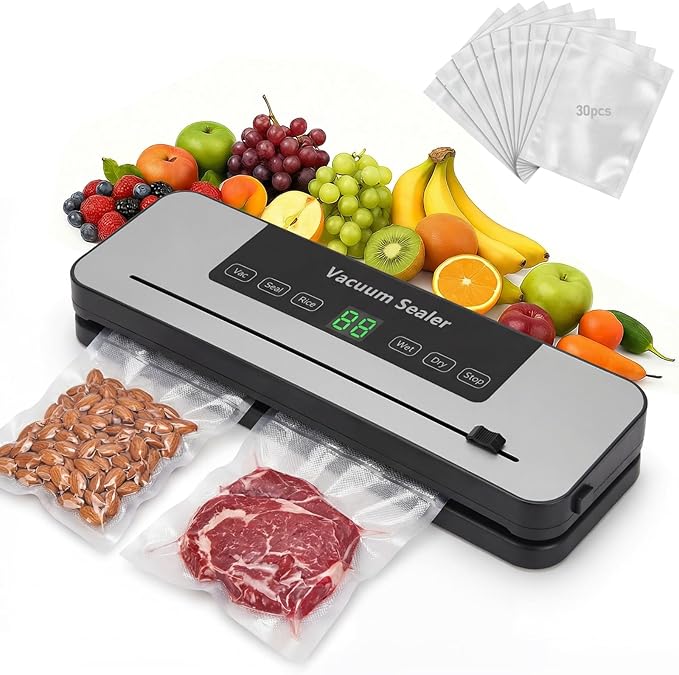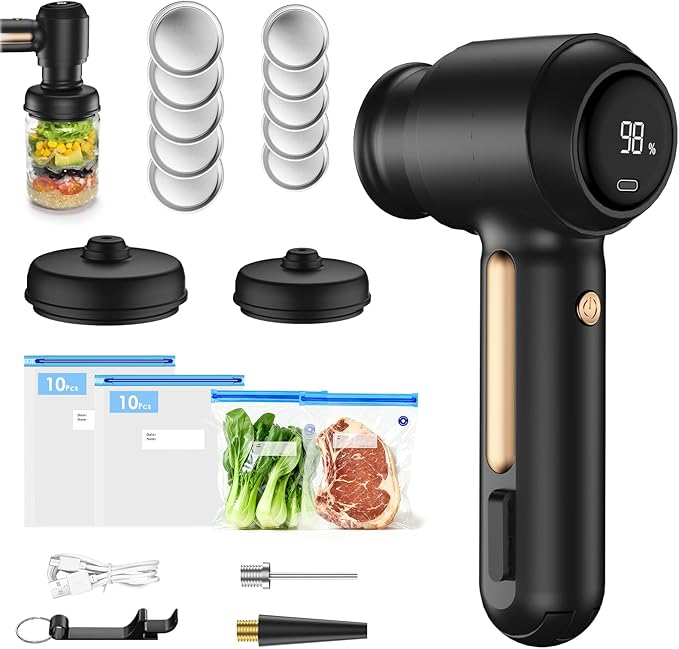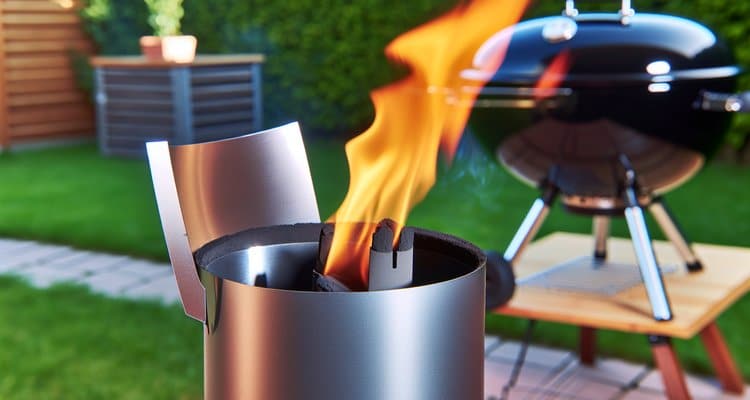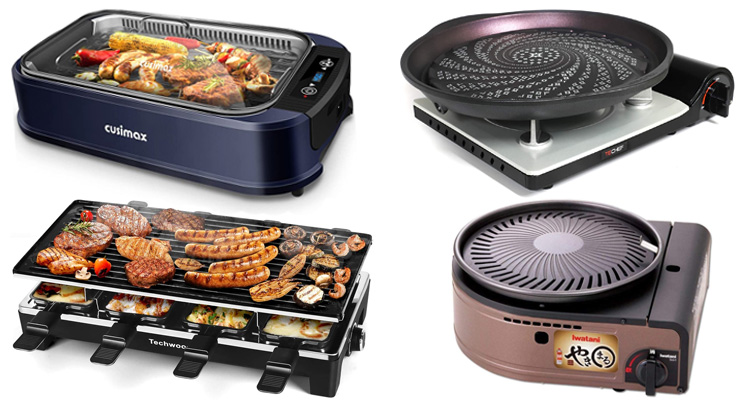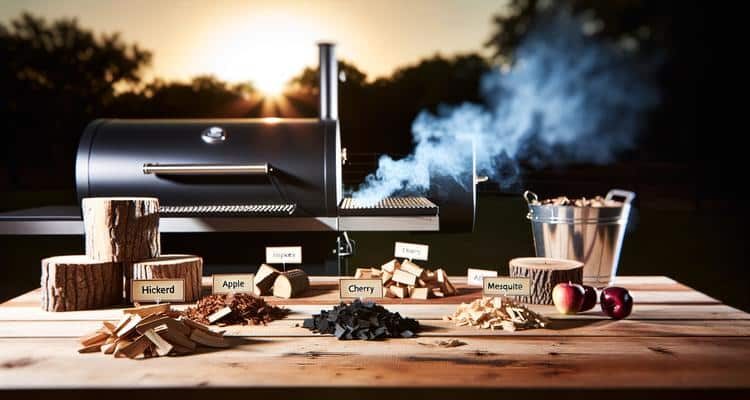
Vacuum sealers have become essential kitchen appliances for anyone serious about food preservation, extending shelf life, and reducing food waste. These powerful devices remove oxygen from storage bags and containers, creating an airtight seal that dramatically extends the freshness of your food while preventing freezer burn. Whether you’re a bulk shopper, meal prepper, sous vide enthusiast, or home food preserver, investing in a quality vacuum sealer pays for itself by saving money on groceries and reducing waste.
In this comprehensive guide, we’ll explore the best vacuum sealers of 2025, from budget-friendly options to professional-grade machines. We’ll examine what makes each model unique, how they perform in real-world testing, and which one might be the perfect fit for your kitchen needs.
Quick Roundup List
- Best Overall: Hydroserenity Vacuum Sealer Machine
- Best Runner-Up: POWOT Precision Food Vacuum Sealer Machine
- Best Budget: LIWUNON 2025 Upgraded Precision Fast-Vacuum Sealer
- Best Premium: Myplinar Vacuum Sealer Machine
- Best Compact: InstaSeal Vacuum Sealer
- Best for Liquids: Gasbye Chamber Vacuum Sealer
- Best for Mason Jars: MFTEK Electric Mason Jar Vacuum Sealer Kit
What is a Vacuum Sealer?
A vacuum sealer is a kitchen appliance designed to remove air from specially designed bags or containers before sealing them airtight. By eliminating oxygen, vacuum sealers significantly slow down the oxidation process that causes food to spoil. This preservation method can extend the shelf life of refrigerated foods by 3-5 times and frozen foods by up to 5 times compared to conventional storage methods.
Distinctive Features
- Suction Power: Determines how effectively the sealer removes air from bags.
- Sealing Capabilities: Heat sealing strength and consistency.
- Operation Modes: Settings for dry, moist, and delicate foods.
- Accessory Compatibility: Ability to work with containers, canisters, and wine stoppers.
- Size and Portability: Counter space requirements and storage considerations.
- Ease of Use: User-friendly controls and operation.
Types of Vacuum Sealers
- External Vacuum Sealers: The most common and affordable type, these machines work by placing the open end of a bag into the vacuum chamber, where air is extracted before heat-sealing the bag.
- Chamber Vacuum Sealers: Professional-grade machines that place the entire bag inside a chamber, removing air from both the bag and chamber simultaneously. These are ideal for liquid-rich foods and high-volume needs.
- Handheld Vacuum Sealers: Compact, portable devices that work with specialized zipper bags equipped with valve systems. These are budget-friendly but have limited functionality.
- Commercial Vacuum Sealers: Heavy-duty machines designed for high-volume usage, typically featuring powerful motors and continuous sealing capabilities.
Benefits of Vacuum Sealers
- Extended Food Freshness: Keep food fresh up to 5 times longer than conventional storage methods.
- Reduced Food Waste: Preserve bulk purchases and leftovers effectively.
- Cost Savings: Buy in bulk and store without spoilage concerns.
- Space Efficiency: Vacuum-sealed packages take up less storage space.
- Sous Vide Preparation: Create perfect bags for precision cooking.
- Marinade Enhancement: Speed up marinating with vacuum pressure.
- Freezer Burn Prevention: Protect frozen foods from air exposure and moisture loss.
How to Choose a Vacuum Sealer
When selecting a vacuum sealer, consider these crucial factors:
- Intended Use: Are you a casual user, meal prepper, bulk buyer, or professional?
- Power and Performance: Higher wattage typically means faster, more effective sealing.
- Sealing Options: Look for models with multiple modes for different food types.
- Ease of Use: User-friendly controls and simple bag insertion matter.
- Size and Storage: Consider your available counter space and storage needs.
- Additional Features: Built-in bag storage, cutter, accessory port, and compatibility.
- Price Range: Balance features with budget constraints.
Product Reviews
Hydroserenity Vacuum Sealer Machine – Best Overall
The Hydroserenity Vacuum Sealer Machine stands out as our top pick thanks to its powerful dual pump system that delivers 3X faster sealing compared to standard models. This compact yet mighty sealer is perfect for bulk meat storage, meal prep enthusiasts, and anyone looking to extend the freshness of their groceries without sacrificing counter space.
Highlights
- 3X Faster Sealing with dual pump system for bulk meat storage and meal prep
- Compact Design fits seamlessly into kitchen without bulk
- Preserves Freshness Up to 5X Longer for seasonal produce and marinated meats
- Gentle Manual Control for delicate foods without crushing texture
Specifications
- Brand: Hydroserenity
- Type: Food Vacuum Sealer
- Power: Electric
- Suction Power: 80 Kpa
Customer Reviews
- “Works like a charm once you get the hang of it. Strong suction and seals well. Great value.”
- “Powerful suction that crushed a beer can in testing. Works great for food storage.”
- “Great item, works perfectly on dry goods and meats. Easy to use with clear instructions.”
POWOT Precision Food Vacuum Sealer Machine – Best Runner-Up
The POWOT Precision Food Vacuum Sealer Machine delivers professional-grade performance with its leak-proof double heat seal technology featuring 17mm dual sealing strips. The upgraded dual high-pressure vacuum pump operates quietly while providing powerful suction, making it an excellent choice for serious home cooks and meal preppers.
Highlights
- Leak-Proof Double Heat Seal Technology with 17mm dual sealing strips
- Powerful Low-Noise Suction with upgraded dual high-pressure vacuum pump
- 6 Versatile Modes for Moist, Dry, Seal Only, Vac Only, Marinate, and Canister
- Built-in bag storage and cutter with 5-year warranty
Specifications
- Brand: POWOT
- Type: Food Vacuum Sealer
- Power: Electric
- Warranty: 5 Years
Customer Reviews
- “Works perfectly and seals tightly every time. Strong suction and easy one-button use.”
- “Easy to use, attractive appearance, and the external vacuuming function works well.”
- “Super handy little helper. Strong seal with no air leaking out. Use it every week now.”
LIWUNON 2025 Upgraded Precision Fast-Vacuum Sealer – Best Budget
The LIWUNON 2025 Upgraded Precision Fast-Vacuum Sealer offers exceptional value with its premium stainless steel construction and plug-and-play design. The reinforced pump is rated for an impressive 100,000 uses—equivalent to up to 20 years of performance—making it a smart long-term investment for budget-conscious buyers.
Highlights
- Premium Stainless Steel construction with compact plug-and-play design
- Double Heat Seal with durable pump rated for up to 20 years of performance
- Exceptional Durability with reinforced pump rated for 100,000 uses
- Multiple modes: Dry, Moist, Pulse, Countdown, Canister, Marinate, Double Seal
Specifications
- Brand: LIWUNON
- Type: Food Vacuum Sealer
- Power: Electric
- Pump Rating: 100,000 uses
Customer Reviews
- “Game-changer for food preservation. Double heat seal ensures airtight secure seals.”
- “Absolutely love this vacuum sealer. Easy to use even for elderly users. Recommended.”
- “Great value. Strong vacuum and double seal is secure. Timer feature is a plus.”
Myplinar Vacuum Sealer Machine – Best Premium
The Myplinar Vacuum Sealer Machine comes complete with 30 storage bags and a built-in sliding cutter, offering everything you need to get started right out of the box. The one-touch 6-in-1 operation handles both wet and dry foods with ease, while the compact design stores conveniently in cabinets or on countertops.
Highlights
- Powerful Fast Sealing for regular or freezer food storage
- One-Touch 6-in-1 Operation for wet and dry food preservation
- Includes 30 Storage Bags and built-in sliding cutter
- Compact and space-saving design for countertops or cabinets
Specifications
- Brand: Myplinar
- Type: Food Vacuum Sealer
- Power: Electric
- Includes: 30 Storage Bags
Customer Reviews
- “Compact and easy to use. 30 bags included gets you started right away.”
- “One-touch operation works smoothly. Good for both wet and dry foods.”
- “Great budget option that does the job well. Built-in cutter is convenient.”
InstaSeal Vacuum Sealer – Best Compact
The InstaSeal Vacuum Sealer features a remarkably compact footprint of just 5x5x9 inches, making it perfect for small kitchens, apartments, or RVs. Despite its size, this sealer delivers reliable performance with automatic sensor precision technology that prevents oversealing while ensuring airtight double seals every time.
Highlights
- Compact Footprint design at 5x5x9 inches fits anywhere
- Prevents Freezer Burn by removing air and locking in flavor
- Airtight Double Seal ensures food stays fresher longer
- Automatic Sensor precision technology prevents oversealing
Specifications
- Brand: InstaSeal
- Type: Food Vacuum Sealer
- Power: Electric
- Dimensions: 5″ x 5″ x 9″
Customer Reviews
- “Space-saving upright design is perfect for small kitchens. Works great.”
- “Easy to use and prevents freezer burn effectively. Automatic sensor is smart.”
- “Compact but powerful. Great for sous vide prep and food storage.”
Gasbye Chamber Vacuum Sealer – Best for Liquids
The Gasbye Chamber Vacuum Sealer is the ultimate choice for sealing liquids, soups, marinades, and chunky foods that would be impossible with standard external vacuum sealers. The 5.28QT chamber capacity with an 11.5-inch sealing bar handles large batches, while replaceable dual heating wires backed by a 3-year warranty ensure long-term reliability.
Highlights
- Removes Nearly All Air from ground meat, chunky foods, and liquids
- All-in-One Food Preservation for solids and liquids including soups
- 5.28QT Chamber Capacity with 11.5-inch sealing bar
- Replaceable Dual Heating Wires with 3-Year Quality Coverage
Specifications
- Brand: Gasbye
- Type: Chamber Vacuum Sealer
- Power: Electric
- Chamber Capacity: 5.28QT
- Sealing Bar: 11.5 inches
- Warranty: 3 Years
Customer Reviews
- “The sealer works great for liquids and ground meat. Worth every penny.”
- “Chamber design handles wet food much better than suction sealers.”
- “Perfect for soups, marinades, and bulk food prep. Very well made.”
MFTEK Electric Mason Jar Vacuum Sealer Kit – Best for Mason Jars
The MFTEK Electric Mason Jar Vacuum Sealer Kit offers unique 3-in-1 versatility, working with mason jars, vacuum bags, and food containers. The kit includes 20 reusable vacuum bags and 10 mason jar lids, making it perfect for pantry organization, salad prep, and dry goods storage. The compact handheld design is about the size of a pepper grinder.
Highlights
- 3-in-1 Versatility for mason jars, vacuum bags, and food containers
- Includes 20 Reusable Vacuum Bags and 10 Mason Jar Lids
- Compact Handheld Design the size of a pepper grinder
- One-click start with Auto-stop after 120 seconds
Specifications
- Brand: MFTEK
- Type: Handheld Vacuum Sealer
- Power: Electric
- Includes: 20 Reusable Bags, 10 Mason Jar Lids
Customer Reviews
- “Great for sealing individual salad servings in mason jars. No more waste.”
- “Compact and portable. Works well for mason jars and bags.”
- “Handy 3-in-1 design. Good value for the price with included accessories.”
Understanding Vacuum Sealer Technology
Vacuum sealers work on a straightforward principle: remove oxygen from food packaging to slow spoilage and preserve freshness. Let’s look at how these machines accomplish this task.
How Vacuum Sealers Work
- Air Extraction: The vacuum sealer pulls air out of the bag or container using a motorized pump. External models extract air through the open end of a bag, while chamber models remove air from the entire enclosed space.
- Sealing: Once sufficient air is removed, a heated bar melts the plastic bag, creating an airtight seal that prevents oxygen from re-entering.
- Cooling: The seal needs a moment to cool and set properly before handling, which most automatic models account for in their cycle time.
External vs. Chamber Vacuum Sealers
External Vacuum Sealers:
- More affordable and compact
- Extract air from the open end of the bag
- Cannot effectively seal liquids without freezing first
- Require special textured vacuum bags
- Ideal for home use and occasional sealing
Chamber Vacuum Sealers:
- More expensive and larger
- Place the entire bag inside a chamber for sealing
- Can seal liquids and moist foods directly
- Use less expensive, non-textured chamber bags
- Better for high-volume sealing and professional use
Vacuum Sealer Applications and Benefits
Vacuum sealers offer numerous practical applications beyond basic food storage. Here are some of the most popular uses:
Food Preservation
- Extend shelf life: Keep food fresh up to 5 times longer
- Bulk shopping: Buy large quantities and divide into meal-sized portions
- Seasonal preservation: Store fruits and vegetables at peak freshness
- Pantry organization: Keep dry goods like rice, flour, and coffee fresh longer
Sous Vide Cooking
Sous vide (French for “under vacuum”) is a cooking technique that requires vacuum-sealed food to be immersed in a precisely temperature-controlled water bath. Vacuum sealers:
- Create airtight packages that won’t float
- Allow for even heat distribution around the food
- Prevent juices and flavors from escaping during cooking
- Enable pre-seasoning and marinating before cooking
Specialty Uses
- Marinating: A vacuum sealer can marinate meats in minutes rather than hours
- Freezer burn prevention: Keep frozen foods protected from air exposure
- Meal prep: Prepare meals in advance for quick reheating
- Travel and camping: Create compact, non-perishable food packages
Maintenance and Care Tips
Proper maintenance ensures your vacuum sealer will provide years of reliable service. Follow these guidelines for optimal performance:
Daily Care
- Wipe down the exterior after each use with a damp cloth.
- Clean the vacuum channel and drip tray to remove any food particles.
- Allow the heat seal bar to cool completely before storing.
Regular Maintenance
- Check the foam gaskets regularly for wear and replace if damaged.
- Clean the heat seal bar with a soft cloth to remove any residue.
- Inspect the power cord for any damage.
- Test the vacuum pressure periodically to ensure proper function.
Troubleshooting Common Issues
- Weak vacuum: Check for debris in the vacuum channel or worn gaskets.
- Poor seals: Ensure the bag is smooth and free of wrinkles at the seal point.
- Machine not powering on: Check connections and power source.
- Overheating: Allow sufficient cool-down time between sealing sessions.
Frequently Asked Questions
How long does vacuum-sealed food last?
Vacuum-sealed food lasts significantly longer than conventionally stored food:
- Refrigerated: 1-2 weeks for most items (vs. 1-3 days).
- Frozen: 1-3 years depending on the food type (vs. 6-12 months).
- Pantry: 3-6 times the normal shelf life for dry goods.
What foods should not be vacuum sealed?
While most foods benefit from vacuum sealing, a few exceptions include:
- Soft cheeses (blue cheese, Brie, Camembert): Can promote anaerobic bacteria growth.
- Fresh mushrooms and garlic: May harbor anaerobic bacteria that thrive without oxygen.
- Fresh bananas: Will continue to ripen and turn mushy.
- Raw onions and cruciferous vegetables: Release gases that can inflate the vacuum bag.
Can any plastic bag be used with a vacuum sealer?
No, standard food storage bags are not suitable for vacuum sealing. Always use specially designed vacuum sealer bags that:
- Are thicker and more durable to withstand vacuum pressure.
- Have textured channels to help air escape (for external sealers).
- Are food-safe and BPA-free.
- Can withstand freezing and, if needed, sous vide cooking temperatures.
Are vacuum sealers worth the investment?
For most households, a vacuum sealer pays for itself quickly through:
- Reduced food waste (up to 87% less wasted food).
- Ability to buy in bulk at lower prices.
- Extended food freshness.
- Preservation of seasonal produce.
- Time savings in meal preparation.
How do you seal liquids with a vacuum sealer?
For external vacuum sealers:
- Freeze liquids first in a container.
- Transfer frozen blocks to a vacuum seal bag.
- Seal normally.
For chamber vacuum sealers:
- Place liquid-filled bag inside the chamber.
- Position the open end on the seal bar.
- Close the chamber and run the vacuum cycle normally.
Conclusion
A quality vacuum sealer is an investment in better food storage, reduced waste, and enhanced culinary possibilities. Whether you’re looking to extend the life of bulk purchases, prepare for sous vide cooking, or simply keep leftovers fresher longer, there’s a vacuum sealer to match your needs and budget.
For most home cooks, the Hydroserenity Vacuum Sealer Machine offers the best combination of features, performance, and value. Its dual pump system delivers fast sealing with a compact footprint, making it our top recommendation.
Those who need to seal liquids and soups should consider the Gasbye Chamber Vacuum Sealer for its ability to handle wet foods without freezing first. Budget-conscious shoppers will appreciate the LIWUNON 2025 Upgraded Precision Fast-Vacuum Sealer for its exceptional durability and long-term value.
No matter which vacuum sealer you choose, you’ll enjoy fresher food, less waste, and greater convenience in your kitchen.
Contents




